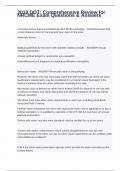2019 DOT: Comprehensive Review for
NRCME Exam Questions & Answers
Corrective lenses that are prohibited by the FMCSA, including: - ANSWER-lenses that
correct distance vision in one eye and near vision in the other.
telescopic lenses
Medical guidelines for the driver with diabetes mellitus include: - ANSWER-Annual
medical examination.
Annual ophthalmologist or optometrist eye evaluation.
Disqualification for a diagnosis of unstable proliferative retinopathy.
Monocular Vision - ANSWER-Monocular vision is disqualifying.
However, the driver who has monocular vision that with the better eye meets all vision
qualification requirements may be considered for a Federal Vision Exemption if the
Medical Examiner finds the driver otherwise medically fit for duty.
Monocular vision is defined as vision that is at least 20/40 for distance in one eye with
or without correction and vision that is less than 20/40 for distance in one eye with or
without correction.
The driver must meet other vision requirements in each eye, including visual fields
(horizontal field of vision).
Federal Vision Exemption: the driver with monocular vision who is applying for or has a
federal exemption or is qualified by operation of 49 CFR 391.64 must have an annual
physical examination.
Drivers with vision loss who meet standards may be certified for up to two years.
A driver who wears contact lenses which correct farsightedness in one eye and
nearsightedness in the other, but has no other visual impairments can be certified under
what additional conditions?
Only if the driver wears prescription glasses which provide the same correction as the
contact lenses.
,FMCSA guidance indicates that a driver should not be certified under these
circumstances.
Only by federal exemption.
The driver is always certifiable under these conditions. - ANSWER-FMCSA guidance
indicates that a driver should not be certified under these circumstances.
Explanation: FMCSA guidance indicates that contact lenses that correct one eye for
distance and one eye for near vision are not acceptable.
Guidance recommends not to certify with ear problem diagnoses of: - ANSWER-a)
Uncontrolled vertigo.
b) Ménière's disease.
c) Nonfunctioning labyrinth.
d) Nonfunctioning fistula.
The medical examiner's role in the exemption process includes _________.
Issuing the exemption.
Issuing the prescription for the driver's contact lenses and/or glasses.
Providing the driver with contact information for the Federal Vision Exemption Program.
Assuring that the driver has peripheral vision of at least 110 degrees in each eye. -
ANSWER-Providing the driver with contact information for the Federal Vision Exemption
Program.
Explanation: The medical examiner's role in the exemption process is limited to
performing the driver examination and providing the driver with contact information for
the FMCSA related to the exemption process.
,An audiometric test produces the following results: Left ear: 500 Hz, 35dB Loss; 1,000
Hz, 35 dB loss; 2,000 Hz 45 dB loss. Right ear: 500 Hz, 40 dB loss; 1,000 Hz, 45 dB
loss; 2,000 40 dB loss. What is the certification?
Certify for one year.
Certify for two years.
Do not certify.
Certify only when accompanied by hearing aid. - ANSWER-Certify for two years.
Explanation: Drivers with an average hearing loss of < 40 decibels averaged across
500, 1000, and 2000 Hz in the better ear may be certified for two years.
What eye conditions must the medical examiner ask the driver about?
Cataracts, color deficiencies, retinitis pigmentosa, aphakia, glaucoma.
Lazy eye, cataracts, aphakia, floaters, retinopathy.
Glaucoma, macular degeneration, retinitis pigmentosa, color deficiencies.
Retinopathy, cataracts, aphakia, glaucoma, macular degeneration. - ANSWER-
Retinopathy, cataracts, aphakia, glaucoma, macular degeneration.
Explanation: These are the "ask about" vision conditions. The medical examiner may
ask the driver about any eye conditions, but should ask the driver about these specified
conditions.
Which of the following drivers' tests meet hearing certification standards?
Whisper test 4 feet right ear, 3 feet left ear.
Whisper test 5 feet right ear with hearing aid, 3 feet left ear without hearing aid.
Audiogram left 30/500 Hz, 40/1000 Hz, 60/2000 Hz; right 25/500 Hz, 35/1000 Hz,
80/2000 Hz.
, Audiogram left 35/500 Hz, 50/1000 Hz, 40/3000 Hz; right 35/500 Hz, 35/1000 Hz,
60/3000 Hz. - ANSWER-Whisper test 5 feet right ear with hearing aid, 3 feet left ear
without hearing aid.
Explanation: Whisper test results require 5 feet in at least one ear for passing, with or
without a hearing aid. Audiometric testing results require an average of 40 dB loss in the
better ear for results averaged across 500, 1000, and 2000 Hz. Although testing may be
performed at 3000 Hz, results obtained are not used to determine whether the driver
meets hearing requirements.
A driver has loss of hearing in the better ear of 25 dB loss at 500 Hz, 40 dB loss at 1000
Hz, and 60 dB loss at 2000 Hz. With respect to the hearing requirement for medical
certification, the driver __________.
May be certified for one year.
May be certified for two years.
May not be certified.
May be certified if examined by an otolaryngologist who is familiar with the CMV driving
duties who certifies the driver as medically qualified to drive a CMV. - ANSWER-May
not be certified.
Explanation: An average hearing loss of 41.7 decibels averaged across 500, 1000, and
2000 Hz in the better ear is disqualifying. The driver should be referred to obtain a
hearing aid and may be certified if the driver passes while wearing a hearing aid. A
specialist cannot determine certification, and a specialist cannot override medical
qualification standards such as the minimum hearing requirement.
Which of the following is acceptable for a driver who wears a hearing aid?
Testing of the driver's hearing is waived if the driver presents a letter from a qualified
specialist.
Testing of the driver's hearing may be performed by the medical examiner using
audiometric testing equipment.
Testing of the driver's hearing may be performed by an audiologist or otolaryngologist
using specialized audiometric testing equipment.




